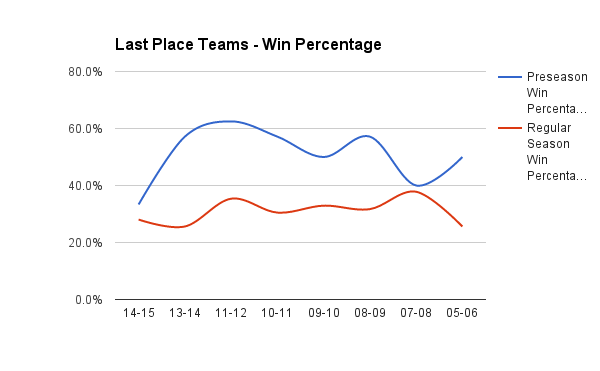© 2025 ALLCITY Network Inc.
All rights reserved.

The offseason is hard for fans of any sport, so it’s no surprise when people attack the preseason like predators taking down their prey. Games are analyzed, and predictions are made about what can be expected from each team in the regular season. Hockey, of course, is no different, and as we bring the 2015 preseason to a close, we have no shortage of discussions on the subject.
Unfortunately, we often engage in the wrong types of conversations when it comes to preseason action. Historically, the preseason is a very poor indicator of regular season performance, so using these handful of games to predict the success or challenges a team will face is unwise.
A common assertion is that a team’s inability to score in the preseason foretells of problems with offensive production in the regular season. An analysis of eight of the past 10 NHL seasons* indicates that this assertion is not accurate. In looking at the average Goals For per game (GF/G) of the President’s Trophy Winner, the Stanley Cup Champions, the team placing last in the league, and the Colorado Avalanche, we see that there is little evidence of a correlation between goals scored in the preseason and those scored in the regular season.
If preseason scoring was indicative of regular season scoring, we’d see similar patterns between the two across the seasons. However, the data is far from that, and not just for one or two teams. Consistently across the best and worst teams of the league, we see few if any patterns or parallels.
In fact, the scoring for last place teams is significantly inverted in that high scoring during the preseason was followed by a lack of scoring in the regular season in a number of years.
This lack of predictive relationships can also be seen in win records. Consider the pre and regular season records of the same four team categories.
Again, we see that what happens in the preseason does not offer a clear indication about what can be expected in the regular season. A team’s wins prior to opening night yield little information about how many wins the team will get later on.
So if looking at a team’s success—or lack thereof—in the preseason does not provide a glimpse into what the regular season has to hold, what type of analysis can be done?
The preseason is ripe with opportunities to analyze individual players and coaches’ decisions. How is Player X adjusting to his new team? What line combinations are developing chemistry? Which group of players is the coach using for special teams, and how are they performing?
The heart of the problem with looking at team performance as a whole is that preseason teams are in flux. Not only are rosters changing as players are sent down to feeder teams and released from professional try out contracts, coaches are tinkering with positions, linemates and pairings in order to see what works and what doesn’t. In addition, competition between teams might be quite lopsided. A team that closely resembles an opening night roster could very well face off against a team filled with mostly AHL talent.
These details contribute to the trends illustrated above: preseason performance is often wildly different from regular season statistics, all of which makes the practice of using the preseason to predict a team’s regular season success misguided and of little value.
* 2012-2013 and 2006-2007 were not included due to a lack of data
Comments
Share your thoughts
Join the conversation











